 TOURISM TOURISM |
Madagascar lies 400 kilometres off the east coast of Africa and offers diverse and spectacular scenery: mountains, deserts, rainforests, dazzling beaches fringing the Indian Ocean and island archipelagos linked by coral reefs and clear turquoise waters.
Madagascar Travel offers an extensive range of hotels, wildlife and birding tours, beach and diving vacations, group travel and tailor-made holidays.
 Towns and Cities Towns and Cities |
 Antananarivo Antananarivo |
Also known as 'Tana', the Malagasy capital is about 1250 m above sea level in the Central Highlands. With a population of around 2 million people, Tana is the centre of the Merina tribe, who resemble the Malayo-Polynesian component of the first Malagasy settlers. The city is set in a basin surrounded by 12 hills. Much of the surrounding countryside is devoted to rice paddies. The houses of highland towns are typically multi-storeyed brick constructions, often with wooden staircases and balconies, built along narrow, cobbled streets and alleyways. Visit the markets, the Parc de Tsimbazaza zoo, museum, botanical gardens and enjoy the restaurants and night-life.
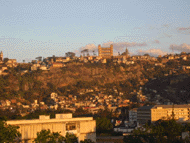
 Antsirabe Antsirabe |
In the colonial era, Antsirabe, 170 km south of Tana, was important for its thermal baths and almost temperate climate. Visitors still enjoy a bath or massage at the spa, but the town is now famed for its many and varied craft centres - including Joseph's Semi-precious Gemstone Shop. The colourful rickshaws are known as 'pousse pousses'. There are two volcanic lakes to the west of the town.
 Fort Dauphin Fort Dauphin |
No other town in Madagascar has such a stunning setting. Fort Dauphin (Tolanaro) is set on a small peninsula backed by high mountains and bordered by long, sandy beaches. Fort Dauphin is the lobster capital of Madagascar and excellent restaurants like the Gina, the Miramar and the Mahavoky offer delectable seafood dishes. The town is the gateway to Berenty and Andohahela Reservfes and to the bizarre spiny desert.
 Tulear Tulear |
This dusty outback probably has the greatest number of different ethnic groups of any Malagasy town. The region is among the poorest in Madagascar. Tulear is near some of Madagascar's most impressive tombs and the gateway to places such as Ifaty Beach, St Augustin Bay, Nosy Ve Marine Reserve, and Isalo National Park.
 Morondava Morondava |
Reminiscent of a 'wild west' movie set, Morondava is the centre of the Menabe Sakalava people. The Morondava basin is baobab country and the hottest region of Madagascar. The town has several seaside hotels and is the gateway to Kirindy Forest and Belo Sur Mer.
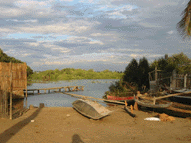
 Beach and diving holiday destinations in Madagascar. Beach and diving holiday destinations in Madagascar. |
 Nosy Be Archipelago Nosy Be Archipelago |
These tropical islands off the northwest coast have some of the region's finest beaches. Most accessible on Nosy Be is Andilana, the northernmost beach. Don't miss the day trip to beautiful, reef-ringed Nosy Tanikely, a marine reserve with a lovely, sunny beach. Nosy Komba has a good, small beach near Ampangorinana village. There are real gems further afield on Nosy Iranja (the 'turtles' island) and in the Mitsio Isles.
 Ile Sainte Marie Ile Sainte Marie |
Along the west coast, there are a number of secluded, palm-lined coves, off which to swim and snorkel and there is a stunning beach on the offshore islet of Ile Aux Nattes. The orchids are at their peak in September and the whales' migration takes place between July and October
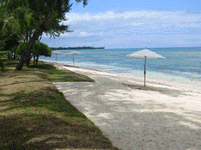
 Ifaty and Nosy Ve Ifaty and Nosy Ve |
Ifaty has a pleasant beach and easy access to the spiny desert. The beach is at its best in front of the hotels Bamboo Club and Vovo Telo. The coral reefs attract scuba divers and there is an excellent PADI diving centre. The offshore islet of Nosy Ve is a terrific place for snorkelling and most people enjoy spending the day on a tiny desert isle. Another attraction is the graceful tropic birds who breed on Nosy Ve.
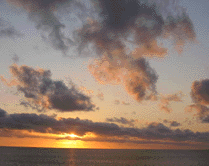
 Morondava Morondava |
The Morondava seafront has a wide, white sandy beach off which it is safe to swim. It is at its best in the vicinity of Hotel Chez Maggie.
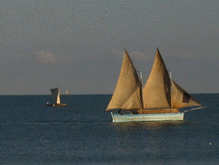
 Island Hopping Island Hopping |
Sail the Indian Ocean on board a luxury private yacht, mooring at inhabited and uninhabited islands in the Nosy Be Archipelago and the remote Mitsio Isles.
 MALAGASY TOWNS AND CITIES DESCRIBED AND ASSESSED FOR THE TRAVELLER MALAGASY TOWNS AND CITIES DESCRIBED AND ASSESSED FOR THE TRAVELLER |
In our experience, the destinations described below are generally best for nature enthusiasts, but you are not restricted to these places. If you would like to visit remote or recently-opened protected areas such as Andringitra in the east, Andohahela in the south-east, Marojejy in the north-east or Tsingy de Bemaraha in the west, please let us know and we will design a suitable itinerary.
 Perinet (Analamazaotra) - Mantadia Perinet (Analamazaotra) - Mantadia |
This montane rainforest harbours the largest of the lemurs, the indri, with its black and white markings and eerie, wailing cry. Eight other species of lemur inhabit the reserve. Four nocturnal species (woolly lemur, sportive lemur, greater dwarf lemur and rufous mouse lemur) are commonly encountered. Pack a torch for night walks.
The 810- hectare reserve claims a world record for frog diversity, with over 100 documented species. Reptiles include the enormous Parson's chameleon. Birders can expect to see blue coua, coral-billed nuthatch vanga and many more. We recommend that birders visit one of the nearby marshes for localised endemics.
About 37 km from Perinet, Mantadia is a spectacular national park spanning 10 000 hectares of primary rainforest inhabited by rare wildlife not found in Perinet. Star attractions include the diadem sifaka, ruffed lemur and all four rainforest-dependent ground-rollers.These rainforest reserves are about 3 hours from Antananarivo. Trails are gentle in Perinet, steeper in Mantadia.
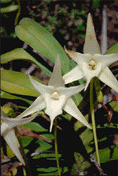
 Ranomafana National Park Ranomafana National Park |
The thundering white-water Namorona River dominates this spectacular upland rainforest in the south-eastern highlands. Ranomafana protects 12 species of lemur, including all three bamboo (gentle) lemurs, ruffed and red-bellied lemurs and the striking Milne-Edward's diadem sifaka. People often see 5 or more species of lemur during a single walk in the rainforest. Rare birds include the brown mesite, Henst's goshawk, rufous-headed ground-roller and Pollen's vanga. Reptiles and frogs abound
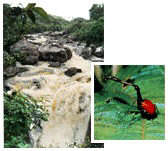
 Masoala National Park and Nosy Mangabe Island Masoala National Park and Nosy Mangabe Island |
The recently gazetted Masoala National Park, east of the town Maroantsetra, protects the largest remaining Malagasy lowland rainforest. In some places, rainforest extends unbroken down to the sea. The Masoala peninsula, much of which remains unexplored, contains a bewildering diversity of plants and animals. In the Bay of Antongil, the uninhabited island reserve of Nosy Mangabe is a stronghold for the ruffed and white-fronted lemurs and the bizarre aye aye. Nosy Mangabe's reptilian denizens include the fringed (leaf-tailed) gecko.
| Only campsites provide accommodation in Masoala and Nosy Mangabe
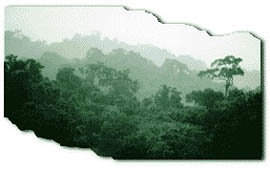
 Montagne d'Ambre National Park Montagne d'Ambre National Park |
This large area of forested volcanic massif, 37 km south of Diego Suarez, was the first Malagasy conservation project to involve local people in planning and management. Lemurs include the crowned and Sanford's brow
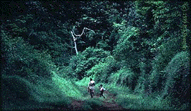
 Berenty Private Reserve Berenty Private Reserve |
With its large populations of ringtails, brown lemurs and Verreaux' sifakas, Berenty is probably the most famous Malagasy reserve. Birding is rewarding. The reserve protects both spiny bush and dry tamarind woodland, along the Mandrare River bank. The guides are among the best in Madagascar, but it is easy (and permitted) to follow the broad trails and explore Berenty independently. The museum has rare examples of Sakalava carvings.
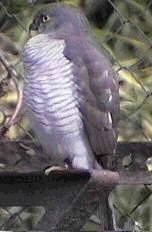
Madagascar Sparrowhawk (Accipiter madagascariensis)
 Ifaty spiny forest Ifaty spiny forest |
Twenty-nine km north of Tulear, Ifaty attracts birders from around the world. It is possible to "tick off" all the rare endemics of the spiny desert zone in one good morning walk. This is a fascinating floristic zone, with bloated trees and plants (baobabs, pachypodiums, hildergardias, moringas) and spiny, drought resistant trees (didiera). The magnificent offshore reefs invite exploration. There is a PADI diving centre and Veso fishermen will ferry snorkellers to the reef by priogue. Between June and August, whales can be observed off Ifaty's beautiful white beaches.
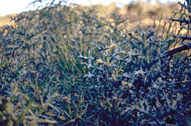
 Isalo National Park Isalo National Park |
A landscape of sandstone rocks cut by canyons and eroded into extraordinary shapes, much of Isalo remains sacred to the Bara tribe. There are old burial sites in the caves of canyon walls. The elephant's foot plant is the emblem of this reserve. It grows on the cliffs, blooms in late winter and represents the drought-resistant life forms that survive in this habitat. The imposing ruiniforme rock formations, the natural pools, and the lush, lemur-inhabited stream banks make Isalo a great hiking venue. In the transition forest of the new Zombitse Forest National Park, an hour's drive from Isalo, birders can see many localised species. The colourful tombs of Andranovory are further along the same road (RN7).
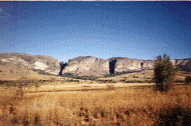
 Kirindy ('Swiss') Forest Kirindy ('Swiss') Forest |
Tropical, dry deciduous forest is the world's most threatened habitat type. This 10 000-hectare reserve, 60 km north of Morondava on the west coast, claims a world record for primate density. There are many lemurs, include the world's smallest primate, the pygmy mouse lemur. Kirindy is the best place to see giant jumping rat and there are fosa (Madagascar's largest predator), various spiny tenrecs, birds and reptiles aplenty. The diverse flora includes three of the six endemic Malagasy baobabs. We recommend an overnight stay in the campsite, but you can visit Kirindy on a full-day excursion
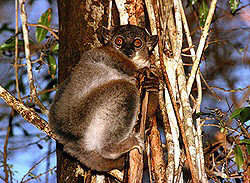
A Microcebe
 Ampijoroa Forest Station Ampijoroa Forest Station |
This outstanding example of western Malagasy tropical dry deciduous forest is 2 hours from the port Mahajanga. Lemurs include the Coquerel's sifaka, mongoose and brown lemurs, and various nocturnal species. The giant hognosed snake, rhinoceros chameleon and fringed gecko are among the interesting reptiles. Rare birds include the Madagascar fish eagle, white-breasted mesite, Coquerel's coua, Schlegel's asity and Van Dam's vanga. At the campsite, you can visit the Durrell Wildlife Trust's breeding project for rare Malagasy tortoises and turtles.
 Ankarana reserve Ankarana reserve |
The landscape is extraordinary and dramatic in this limestone massif, with its fields of razor sharp pinnacles called tsingy. Below, the massif is pierced by caves and canyons. Between sheer cliffs, sunken tropical deciduous forests harbour rare wildlife. The reserve is known for its large concentrations of crowned, Sanford's and sportive lemurs, as well as ringtailed mongoose, fosa, tenrecs and Madagascar striped civet. There is good birding and prolific reptile and invertebrate life. There are few trails in the reserve, vehicular access is limited to the dry season, and accommodation is in campsites.
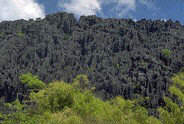
Ankarana Plateau from the savanna
 Andringitra national park Andringitra national park |
This recently gazetted national park, 46 km south of Ambalavao, protects some of Madagascar's most impressive scenery. The second and third highest peaks - Pic Boby and Pic Bory stand within its boundaries. The area is characterised by remarkable granitic domes, exquisite waterfalls, verdant valleys and, at the highest altitudes, remote heathlands. This is the one place in Madagascar where snow has been known to fall and temperatures can fall below zero on winter nights. Andringitra is best visited from late August to March, when small wildlife is most active and most flowering plants bloom. Lush mid- and high-altitude rainforest is rich in fascinating small wildlife and the massif is known for its frog, bird and orchid diversity. The lemurs, which are not habituated to the presence of humans, include bamboo lemurs and ringtails. Andringitra is a favourite with hikers and walkers. There are campsites and a WWF 'gite' or mountain hut. We arrange fully organised camping in Andringitra, all meals and equipment provided
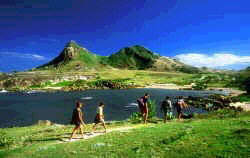
 Lokobe reserve Lokobe reserve |
These 740 hectares conserve the last original Sambirano forest remaining on Nosy Be island, inhabited by black lemur, Nosy Be sportive lemur, panther chameleon and Malagasy tree boa. The survival of the black lemur is threatened by loss of habitat. Sadly, the award-winning Black Lemur Forest Project , which represented the black lemur's best hope of survival, is no longer in operation
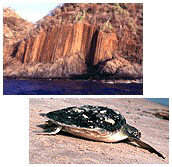
 Nosy tanikely Nosy tanikely |
The snorkelling is superb from this reef-ringed, marine reserve island. A small patch of forest provides roosting sites for fruit bats.
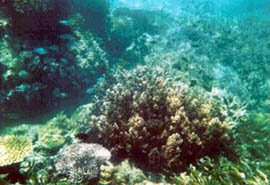 |

